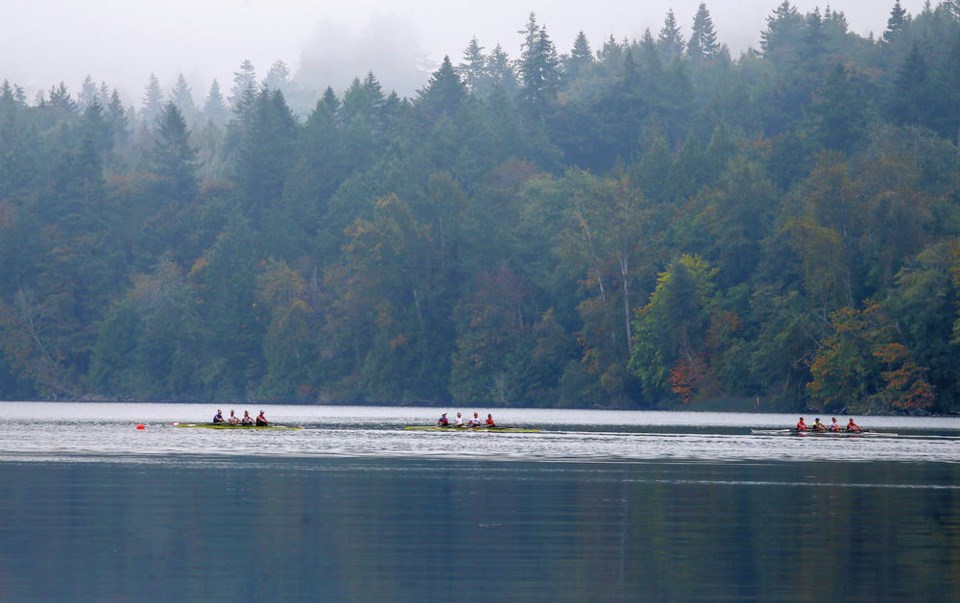Elk/Beaver Lake holds a special place in the heart of our community. Every year more than 1.5 million people visit — to picnic, to teach their toddlers how to swim and to stroll the lakeside trails. The lake is the Island’s most popular fishing lake, and has long been the true home of Canadian rowing.
But our beloved lake is in trouble. Thick weeds invade cherished swimming areas. Officials regularly issue health alerts to keep dogs and kids out of the water because of toxic algae blooms. Indeed, the latest alert was just lifted in mid-February.
At the root of the problem is the relentless onslaught of phosphorus and other nutrients that have washed into the lake over the years — from upstream septic systems, yard fertilizers, farms, and storm-water runoff. This nutrient accumulation creates ideal conditions for weeds and blue-green algae blooms.
Fortunately, help is on the way, driven by a groundswell of community support for action to save the lake. Last fall, the Capital Regional District authorized funds for oxygen-generating equipment to reduce algae growth — and the province has also promised funding.
Oxygenators are a necessary good start, but they are only a stopgap. They don’t do anything to stem the flow of nutrients that continue to wash down the watershed into the lake.
To tackle the long-term pollution problem we need to deal with nutrients already in the lake. But we must also stop the ongoing escape of nutrients from farms and properties upstream.
As John Roe of the Veins of Life Watershed Society puts it: “We must stop this pollution before it enters the environment. Source control is key.”
And that’s why it’s heartening that the CRD has also approved a comprehensive watershed management plan, which lays out a strategy for eliminating long-term pollution by promoting control of nutrient pollution at source.
The Environmental Law Centre at the University of Victoria has analyzed the plan and is calling for it to be vigorously implemented — with a few key improvements.
Among other things, the centre calls for:
• More stringent enforcement of septic-system laws
• Enhanced education of landowners about proper septic maintenance. For example, “septic socials” (where hosts open their septic system for neighbours to learn proper operation) and Septic Welcome Wagons can teach new landowners best practices
• More stringent provincial enforcement of laws on farm manure management — plus strong enforcement of local bylaws related to farm waste
• Encouragement of area-based environmental farm planning — and technical and financial support for enhanced nutrient management on farms
• Financial incentives for landowners to maintain vegetated strips along streams and lakes, to filter out pollution
• Better blue-green algae monitoring, testing and warning signage.
Perhaps most important, local governments must bolster their support for community stewardship groups that work to restore the health of watersheds.
Veins of Life Society has fenced cattle out of an upstream creek, planted pollution-filtering riparian vegetation and constructed manure platforms to reduce nutrient pollution.
Victoria Golden Rods and Reels has supported ecological restoration at Elk/Beaver Lake.
Peninsula Streams Society has already restored wetlands to filter out pollution — and is developing an initiative with Beaver Elk Environmental Stewards to restore the health of Haliburton Brook that flows into Beaver Lake.
These volunteer community groups are not limited to things like restoring stream banks and wetlands to filter out nutrient pollution. They can play a key role by educating their neighbours about best land-management techniques.
At a small scale, they can go door-to-door to chat about how a small change like limiting lawn fertilizer can improve the lake. At a large scale, they can mobilize the thousands of Victorians who want to build a healthy future for Elk/Beaver Lake.
These grassroots groups can add critically important experience, expertise and passion to government policy-making. It is important to note that broad-based community round tables have been key to improving watershed health at the Cowichan River, Coquitlam River and in the Okanagan Basin.
In sum, the new water-management plan has the potential to be a precedent-setting model of sustainability. Done right, it will demonstrate how an entire community can act together to protect a treasured lake.
Years from now, kids splashing and shouting in the sun-sparkled, clean, clear waters of Elk Lake will thank us.
Angela Barna was a law student and Frances Ankenman an articled student at the University of Victoria Environmental Law Centre. Calvin Sandborn QC is the legal director of the centre.



